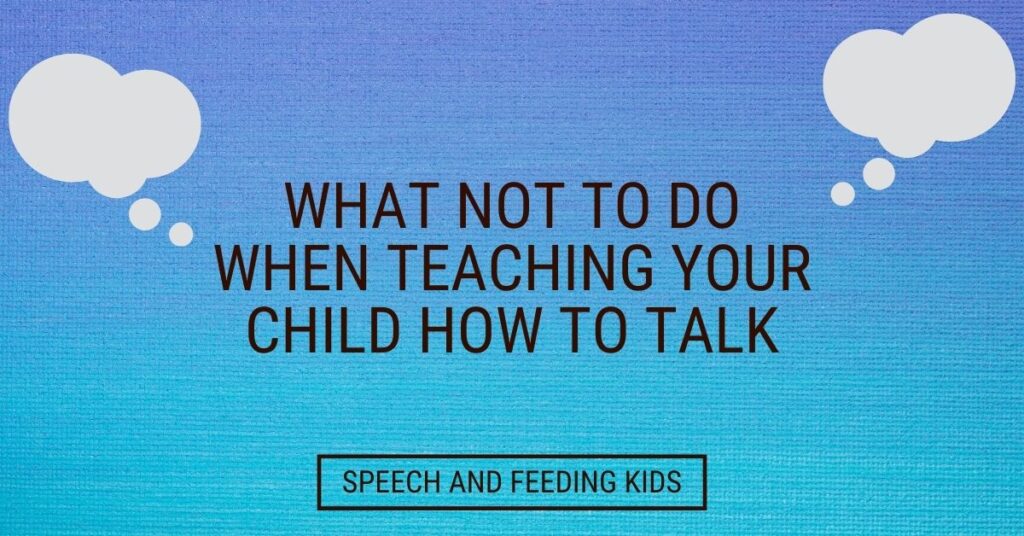Don’t quiz your child.
Imagine being at school and the first day the teacher hands you a test. If it were me, I could imagine a variety of emotions would arise – anxiousness, confusion, frustration. Now imagine the second day the same thing happens, and the third, and every day after that.
Within the first week or two, I would begin to think going to school would not be so much fun.
Now imagine that this was a foreign language class that is brand new to you. How would you respond on the first day if the teacher asked you a question in the new language and then told you to, “use your words” in order to respond?
This teacher created a situation where you’re most likely going to answer incorrectly, or not even try to answer at all.
Now imagine the same scenario except the teacher asked you a question, then taught you how to respond.
The teacher made it abundantly clear that she was trying to teach you, not quiz you, and that any response you made an effort at giving would be accepted. This teacher created a more relaxed space for teaching and learning.
When children are learning to talk make it a point to teach them, and not quiz them.
Eventually, we begin to place more demands and ask them to answer questions; however, we don’t ask those questions until we are absolutely sure they possess the skills necessary to respond to the question.
If the child has never spoken the words, “I want a cookie” we can’t expect them to string these words together by telling them, “use your words”. Especially if they are in a heightened state of frustration or excitement.
Here are some considerations and strategies for how to help your child be successful while learning to talk.
How to help your child be successful while learning to talk
Get their attention
Make sure you have their attention by getting down on their level and bringing their attention towards your face/mouth. It is much harder to imitate if they are not attending to what you’re saying.
Imitation
Imitation is key. Human beings learn by watching and imitating. Model exactly what you want your child to say 2-3 times. There are many techniques and strategies a speech-language pathologist can teach you on how to help your child imitate. One of the most effective strategies I teach parents is say exactly what you want them to say. Instead of, “Mikey can you say I want more”, try just saying, “I want more” using a sing-song voice.
The less you say, the less they will have to process.
Tone
Using a melodic or sing-song voice will help with two things.
- The child will process what you are saying more efficiently
- The sing-song nature of your voice will begin to become a prompt on it’s own. If you are consistent, the child will begin to cue in on when mommy uses that voice, she wants me to try and say what she’s saying
Timing
If you are withholding an item and asking them to imitate you, be quick. If the child becomes upset after the first 5 seconds, that’s your cue that you need to aim for the exchange to be 3-4 seconds next time.
Reinforcement
Praise the child for ANY attempt. Any attempt at trying to do what you are doing should be reinforced
Red Flags
Try to avoid these phrases with new speakers. If you catch yourself saying one, think of a way you can turn it around and tell the child exactly what it is that you want them to say.
- “Use your words”
- “Tell me what you want”
- “I want to hear you say it”
How to measure success
Understand where they are developmentally, and what the next closest step is for them. If they are signing to request, maybe the next step is to sign and pair a sound with the sign. If they can imitate “dada” and “cookie” readily, try putting both words together and see if they will combine in order to request.
Once they start to consistently try to do what you’re asking them, see how you can ever so slightly increase the complexity and build upon what they’re already doing.
Remember to teach first, and ask second.
If you find yourself saying, “use your words” with a new talker, that should be a red flag in your head to take a step back and tell them exactly what you want them to say. If they aren’t able to say exactly what you want them to say, simplify it to a level where they can be successful.
Good luck, practice patience, and have fun!
For more speech and language tips, follow Speech and Feeding Kids on YouTube.
About the Author
DRAKE HASTINGS M.S., CCC-SLP
Drake Hastings is a speech-language pathologist who specializes in speech, oral motor, and feeding therapy for kids. Drake has a passion for working with children and families while helping children achieve goals using a fun and motivating approach to learning.
Drake’s main areas of focus within the practice are feeding therapy, and speech (sound production) therapy. Drake has experience working with children who are diagnosed with Autism Spectrum Disorder, Apraxia of Speech, Dysarthria, Down Syndrome, and rare genetic disorders. Drake has experience working and collaborating with a wide variety of families and therapeutic team members while treating children of all ages.


